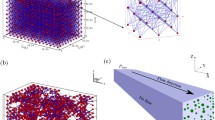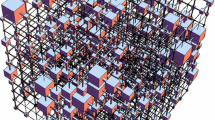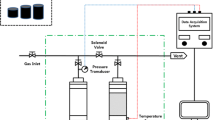Abstract
The transport of natural gas in shale resources is of multiscale and multiphysics nature. The gas transport involves dealing with pores of different length scales and geometrical orientation. Understanding and modeling the interactions of those pores are crucial for proper description of shale matrix deliverability and dynamics. These interactions are less understood at a microscopic scale during the depletion of shale reservoir. In this study, we consider transient flow behavior of a compressible fluid in organic nanoporous material with micro-fractures, or cracks, using a pore network modeling approach. We present a multistep workflow where the transport in the organic nanopores is studied considering the advective–diffusive–adsorptive mechanisms then, coupled with the microcracks for better understanding and optimizing of natural gas organic-rich shale. The natural gas is initially stored in the pore network at high pressure as free and adsorbed fluids and its pressure-driven viscous flow includes additional diffusion mechanisms. The percolation theory is used to obtain some approximations to the organic matrix flow regime coefficients. The organic materials–microcracks coupling term is derived and validated relating the flow rate exchange to the pressure difference with some modifications in order to account for the organic matrix transport dependency on the pressure. The coupling flow exchange term is used to link the local nanoscale heterogeneity to the large scale continuum modeling of shale reservoir. The upscaled model captures the transport exchange during the transient and steady-state flow conditions.












Similar content being viewed by others
Abbreviations
- q :
-
Flow rate (\(\hbox {nm}^{3}\hbox {/s}\))
- P :
-
Pressure (psi)
- \({P}_{\mathrm{f}}\) :
-
Pressure in the crack (psi)
- \({P}_{\mathrm{om}}\) :
-
Pressure in the organic material (psi)
- \({P}_{\mathrm{i}}\) :
-
Initial pressure of the network (psi)
- \({P}_{\mathrm{c}}\) :
-
Confining pressure (psi)
- A :
-
Cross-sectional area perpendicular to flow (\(\hbox {nm}^{2})\)
- \({R}_{\mathrm{P}}\) :
-
Percolation throat size of the network (nm)
- \({R}_{\mathrm{P,ads}}\) :
-
Percolation throat size adjusted for the adsorbed phase thickness (nm)
- \(\mu \) :
-
Dynamic viscosity of natural gas (psi s)
- \({D}_{\mathrm{sv}}\) :
-
Adsorbed phase velocity constant (\(\hbox {nm}^{2}\)/psi s)
- \({D}_{\mathrm{k}}\) :
-
Knudsen diffusivity coefficient (\(\hbox {nm}^{2}\hbox {/s}\))
- \(R^{*}\) :
-
Viscous correction factor for the presence of the adsorbed layer
- \({b}_{\mathrm{kn}}\) :
-
Knudsen diffusion factor
- k :
-
Intrinsic permeability (\(\upmu \hbox {D}\))
- \({k}_{\mathrm{app}}\) :
-
Apparent organic material permeability (\(\upmu \hbox {D}\))
- \({k}_{\mathrm{f}}\) :
-
Microcracks permeability (\(\upmu \hbox {D}\))
- \({k}_{\mathrm{om}}\) :
-
Organic matter intrinsic permeability (\(\upmu \hbox {D}\))
- \(\rho _{\mathrm{ads}}\) :
-
Adsorbed phase density (\(\hbox {lb/ft}^{3})\)
- \(\rho _{\mathrm{bulk}}\) :
-
Bulk phase density (\(\hbox {lb/ft}^{3})\)
- \(\sigma \) :
-
Shape factor (\(\hbox {1/nm}^{2}\))
- \({f}_{\mathrm{T}}\) :
-
Transient effect factor
- \(\psi \) :
-
Pseudo-pressure function
- \(\emptyset \) :
-
Porosity
References
Ambrose, R.J., Hartman, R.C., Diaz-Campos, M., Akkutlu, I.Y., Sondergeld, C.H.: Shale gas-in-place calculations part I: new pore-scale considerations. SPE J. 17, 219–229 (2012)
Celia, M.A., Reeves, P.C., Ferrand, L.A.: Recent advances in pore scale models for multiphase flow in porous media. Rev. Geophys. 33, 1049–1057 (1995)
Cardott, B.J., Landis, C.R., Curtis, M.E.: Post-oil solid bitumen network in the Woodford Shale, USA—a potential primary migration pathway. Int. J. Coal Geol. 139, 106–113 (2015). doi:10.1016/j.coal.2014.08.012
Chen, S., Han, Y., Fu, C., Zhang, h., Zhu, Y., Zuo, Z.: Micro and nano-size pores of clay minerals in shale reservoirs: implication for the accumulation of shale gas. Sediment. Geol. 342, 180–190 (2016). doi:10.1016/j.sedgeo.2016.06.022
Curtis, E.M.: Influence of thermal maturity on organic shale microstructure. (n.d.). Retrieved October 4, 2017, from http://www.ogs.ou.edu/MEETINGS/Presentations/2013Shale/2013ShaleCurtis.pdf (2013)
Ertekin, T., King, G.A., Schwerer, F.C.: Dynamic gas slippage: a unique dual-mechanism approach to the flow of gas in tight formations. SPE Form. Eval. 1, 43–52 (1986)
Fathi, E., Akkutlu, I.Y.: Mass transport of adsorbed-phase in stochastic porous medium with fluctuating porosity field and nonlinear gas adsorption kinetics. Transp. Porous Media 91, 5–33 (2011)
Fathi, E., Tinni, A., Akkutlu, I.Y.: Shale gas correction to Klinkenberg slip theory. SPE Americas Unconventional Resources Conference (2012)
Gangi, A.F.: Variation of whole and fractured porous rock permeability with confining pressure. Int. J. Rock Mech. Min. Sci. Geomech. Abstr. 15, 249–257 (1978)
Heller, R., Vermylen, J., Zoback, M.: Experimental investigation of matrix permeability of gas shales. AAPG Bull. 98(5), 975–995 (2014). doi:10.1306/09231313023
Hou, Y., He, S., Wang, J., Harris, N.B., Cheng, C., Li, Y., Pedersen, P.: Preliminary study on the pore characterization of lacustrine shale reservoirs using low pressure nitrogen adsorption and field emission scanning electron microscopy methods: a case study of the Upper Jurassic Emuerhe Formation, Mohe basin, northeastern China. Can. J. Earth Sci. 52, 294–306 (2015)
Hsieh, T.-H., Huang, Y.-S., Shen, M.-Y.: Mechanical properties and toughness of carbon aerogel/epoxy polymer composites. J. Mater. Sci. 50, 3258–3266 (2015)
Javadpour, F.: Nanopores and apparent permeability of gas flow in mudrocks (shales and siltstone). J. Can. Pet. Technol. 48, 16–21 (2009)
Jiao, K., Yao, S., Liu, C., Gao, Y., Wu, H., Li, M., Tang, Z.: The characterization and quantitative analysis of nanopores in unconventional gas reservoirs utilizing FESEM-FIB and image processing: an example from the lower Silurian Longmaxi Shale, upper Yangtze region, China. Int. J. Coal Geol. 128–129, 1–11 (2014). doi:10.1016/j.coal.2014.03.004
Joekar-Niasar, V., Hassanizadeh, S.M.: Analysis of fundamentals of two-phase flow in porous media using dynamic pore-network models: a review. Crit. Rev. Environ. Sci. Technol. 42, 1895–1976 (2012)
Kang, S.M., Fathi, E., Ambrose, R.J., Akkutlu, I.Y., Sigal, R.F.: Carbon dioxide storage capacity of organic-rich shales. SPE J. 16, 842–855 (2011)
Klaver, J., Desbois, G., Littke, R., Urai, J.L.: BIB-SEM pore characterization of mature and post mature Posidonia Shale samples from the Hils area, Germany. Int. J. Coal Geol. 158, 78–89 (2016). doi:10.1016/j.coal.2016.03.003
Klinkenberg, L.J.: The permeability of porous media to liquids and gases. API Drill. Prod. Pract. 200–213 (1941)
Kou, R., Alafnan, S.F.K., Akkutlu, I.Y.: Multi-scale analysis of gas transport mechanisms in kerogen. Transp. Porous Media 116, 493–519 (2016)
Mavko, G.M., Nur, A.: The effect of nonelliptical cracks on the compressibility of rocks. J. Geophys. Res. 83, 4459 (1978)
Mehmani, A., Prodanović, M., Javadpour, F.: Multiscale, multiphysics network modeling of shale matrix gas flows. Transp. Porous Media 99, 377–390 (2013)
O’Carroll, C., Sorbie, K.S.: Generalization of the Poiseuille law for one- and two-phase flow in a random capillary network. Phys. Rev. E 47, 3467–3476 (1993)
Rahmanian, M., Aguilera, R., Kantzas, A.: A new unified diffusion—viscous-flow model based on pore-level studies of tight gas formations. SPE J. 18(1), 38–49 (2013)
Riewchotisakul, S., Akkutlu, I.Y.: Adsorption–enhanced transport of hydrocarbons in nanometer-scale organic pores. SPE-175107, paper presented during the SPE Annual Technical Conference and Exhibition in Houston (2015)
Sakhaee-Pour, A., Bryant, S.L.: Gas permeability of shale. SPE Reserv. Eval. Eng. 15(4), 401–409 (2012)
Singh, H., Javadpour, F., Ettehadtavakkol, A., Darabi, H.: Nonempirical apparent permeability of shale. SPE Reserv. Eval. Eng. 17, 414–424 (2014)
Warren, J., Root, P.: The behavior of naturally fractured reservoirs. Retrieved October 05, 2017, from https://www.onepetro.org/journal-paper/SPE-426-PA (1963)
Wasaki, A., Akkutlu, I.Y.: Permeability of organic-rich shale. SPE J. 20(6), 1384–1396 (2015)
Wasaki, A., Akkutlu, I.Y.: Dynamics of fracture–matrix coupling during shale gas production: pore compressibility and molecular transport effects. In: SPE Annual Technical Conference and Exhibition (2015)
Yang, C., Zhang, J., Han, S., Xue, B., Zhao, Q.: Classification and the developmental regularity of organic-associated pores (OAP) through a comparative study of marine, transitional, and terrestrial shales in China. J. Nat. Gas Sci. Eng. 36, 358–368 (2016). doi:10.1016/j.jngse.2016.10.044
Zhang, R., Ning, Z., Yang, F., Wang, X., Zhao, H., Wang, Q.: Impacts of nanopore structure and elastic properties on stress-dependent permeability of gas shales. J. Nat. Gas Sci. Eng. 26, 1663–1672 (2015)
Zhou, S., Yan, G., Xue, H., Guo, W., Li, X.: 2D and 3D nanopore characterization of gas shale in Longmaxi formation based on FIB–SEM. Mar. Pet. Geol. 73, 174–180 (2016)
Zimmerman, R.W., Chen, G., Hadgu, T., Bodvarsson, G.S.: A numerical dual-porosity model with semianalytical treatment of fracture/matrix flow. Water Resour. Res. 29, 2127–2137 (1993)
Author information
Authors and Affiliations
Corresponding author
Appendices
Appendix A: Discretization of the Mass Balance in the Pore Network Model:
The calculations around each node (pore) are done by the material balance equation given in Eq. 1. Then, the discretized form is illustrated by taking a single pore interconnected with two throats as shown in Fig. 12.
To avoid complexity, the fluid velocity in the discretized form is taken as the Hagen–Poiseuille velocity. The same procedure can be done with the modified Hagen–Poiseuille form.
Then, the mass flux is:
Mass accumulation:
Continuity equation becomes:
where \(V^{*}\) is the pore volume corrected for the presence of the adsorbed layer using Langmuir adsorption model:
Rearrangement and simplification of the equation:
System of nonlinear equations is to be solved for pressure at each pore as a function of time step \(\Delta {t}\).
a, b, c, d, e ... are all function of pressure and that nonlinear system of equations can be solved using the iterative Newton–Raphson method:
For the multiscale network, the velocity in the crack is given by Eq. (12).
Appendix B: The Use of Crank Sphere Model in Defining the Transient Factor
On our case, the Crank sphere model cannot be used directly as given in Zimmerman et al. (1993) because of the pressure dependence of the organic material permeability.
One way to linearize the problem is to replace the pressure with a pressure function \(\square \). In this case, the permeability k would be the intrinsic or liquid permeability.
Rearrangement:
Taking the log of both sides, then the plot of the right-hand side versus the left-hand side in the Cartesian coordinate should be a straight line with y-intercept \(=\) 0. That is validated using the data obtained from the network as shown in Figs. 13 and 14.
Rights and permissions
About this article
Cite this article
Alafnan, S.F.K., Akkutlu, I.Y. Matrix–Fracture Interactions During Flow in Organic Nanoporous Materials Under Loading. Transp Porous Med 121, 69–92 (2018). https://doi.org/10.1007/s11242-017-0948-3
Received:
Accepted:
Published:
Issue Date:
DOI: https://doi.org/10.1007/s11242-017-0948-3






